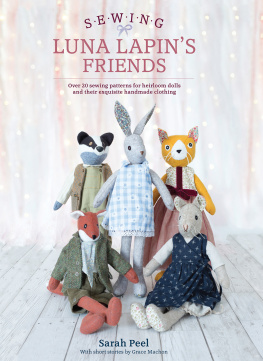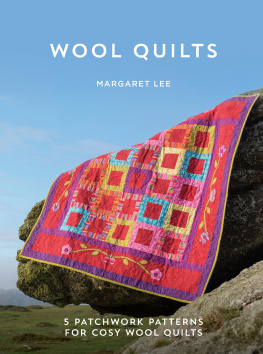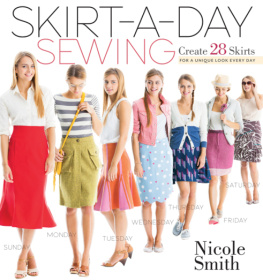Contents
Guide
SEWING
LUNA LAPINS
FRIENDS

Sarah Peel
With short stories by Grace Machon

www.sewandso.co.uk
CONTENTS
FOREWORD
Luna Lapin, our original rabbitty-hare, was created in 2013 as a muse for the tiny clothing designs that were in my head. Since then Luna has become quite a global celebrity and has her own book, Making Luna Lapin. Of course, such a kind rabbit was always going to have friends, and this book teaches you to make them and their stylish, interchangeable clothing. We dont regard the animals as toys, they are more heirloom pieces, or an indulgence for all of us who are still children at heart. We hope you enjoy Lunas little world.

Luna
and the
Fine Old Thing

When Luna Lapin was a kitten she spent Tuesdays with her Granny. Granny Rabbit was a sweet old thing who walked with a single cane and had the largest collection of scarves known to rabbitkind. Luna loved her dearly, and always looked forward to their time together. Granny had many projects and her house brimmed with old books and fabric, some older than herself, which for a little rabbit seemed quite nearly impossible.
Luna loved to hear stories of where these beautiful things had come from. There was smooth, cold cotton from Egypt, ribbons that had been saved from birthday cakes and clippings of lace from wedding dresses. Metres of silk that slipped through the fingers like liquid, and the most wonderful assortment of prints you wouldnt even begin to imagine.
Granny Rabbits house was a treasure trove of imagination, so much so Luna truly believed that fairies sipped the milk left on the bird table for them overnight and that the mice that lived there really did steal Grannys glasses.
One day, just after Luna had gotten out of the bath, her bob tail fluffed up once more after a long day making mud pies with her naughty little brother, Granny asked Luna if she would like to learn something new. Now Luna was never one to shy away from new things so of course she said yes.
Grannys sewing machine was a fine old thing, a beautiful trio of red flowers stood out on its glossy black bow, the blooms outlined in gold. Luna had watched in wonder as Granny had picked out fabrics, laid tissue paper in all sorts of odd shapes upon them and began to cut with such great confidence and her tongue poking out of her mouth (a habit that was somewhat of a family trait). And with the beating of a foot (something that for a rabbit was quite easy) and the whirr of cogs and bobbins something amazing would soon be fashioned and slipped over little Lunas head.
Luna sat patiently as her Granny explained the best way to place your pins, how to hold the scissors so you get the cleanest, straightest line. Now you just have to make friends with your sewing machine, Granny said. And Luna did, every Tuesday, for her little world was meant to be full of perfect choices, perfect dresses.
Materials
This section describes the materials and equipment you will need to make the projects in this book.
BEFORE YOU START
Before starting a project, look at the You Will Need list for the project and gather your supplies. Give yourself enough space and time to work this really does help eliminate mistakes. Read through all of a projects instructions first and highlight any areas that you will need to focus on more than the simpler parts. Press fabric with a suitable iron temperature to ensure it is flat and easy to work with.
BASIC SEWING KIT
You will need some general supplies for making the projects in the book, including the following:
- Selection of needles, including sewing needle, tapestry needle, darner needle and doll needle (for sewing on arms)
- Sewing threads to suit projects, including embroidery threads
- Pins and safety pins
- Sharp scissors for fabric and scissors for paper
- Fabric marker (e.g. water-soluble pen or chalk)
- Adhesive tape
- Implement for turning parts through and stuffing (e.g. knitting needle or chopstick)
- Iron
- Sewing machine
FABRICS
Various fabric types have been used for the projects in the book and this section gives some advice on using them.
Felt
Felt is possibly the perfect crafting material. The felt I am referring to in this book is a flat fabric-like felt, not what you would use for needle-felting or wet felting. Felt is not a woven fabric, but is formed by the agitation of fibres and therefore will not fray when you cut it. This allows you to cut a shape that can be appliqud, or sewn to the outside of a project. However, not all felts are made equal, so if possible choose a felt that has wool in it, and look for a thickness of about 1.5mm (116in) definitely no thicker. I adore the softly marled tones of the felts that are used for Luna and her clothes, which are a wool and viscose blend (see ). Felt doesnt have a grain to the material, so you can move your pattern pieces around to get the most out of your felt.
Corduroy
Corduroy is a fabric that has a luxurious look and feel. The fabric is made up of ribs of tufted fibres, called wales. Colours seem to glow in corduroy; think of it as a practical, everyday velvet. As with all of Luna and her friends projects, its important to think of their scaled down world, so choose a fine needlecord (one that has 14 wales per inch or higher).
TIPS ON SEWING WITH CORDUROY
When cutting out the corduroy, all pattern pieces should be laid up and cut in the same direction, because corduroy has a pile which means it looks a different shade one way to the opposite way our layouts follow these principles.
Wool Tweed
The beautiful soft colours and natural fibres of wool tweed make it perfect for Lunas fashionable wardrobe. Tweed is a heritage fabric and when buying it is worth researching the provenance of what you are investing in. Dont think you have to go out and buy a huge amount though it may be you could recycle an old tweed jacket into a skirt and bag for Luna. Save scraps too, as the tiniest pieces can be used for appliqu. Avoid anything too chunky as Lunas clothes are a miniature scale, which means you need something midweight rather than heavy. If you are worried about matching stripes or checks, turn the fabric to be on the bias (so the pattern is diagonal) as this will give a different, less designcritical look.
Printed Fabrics
Cottons tend to be more stable than other fabric compositions and therefore will give you more control when you are sewing these small items. Choose prints that work with the scale of the garment thats why I love the ditsy prints you will see in the projects. Choose fabrics that are lightweight without being delicate a quilting weight is about as heavy as you should select.
Trims
There are some wonderful trims and haberdashery available, designed to make sewing easier as well as more beautiful. The most important consideration when choosing trims is scale: try to use doll buttons rather than those you would use for your own clothing. Select narrow ricrac or ribbon so it looks like it belongs in a miniature world. Be inventive these designs are just a starting point and the best creations are of your own invention.


















